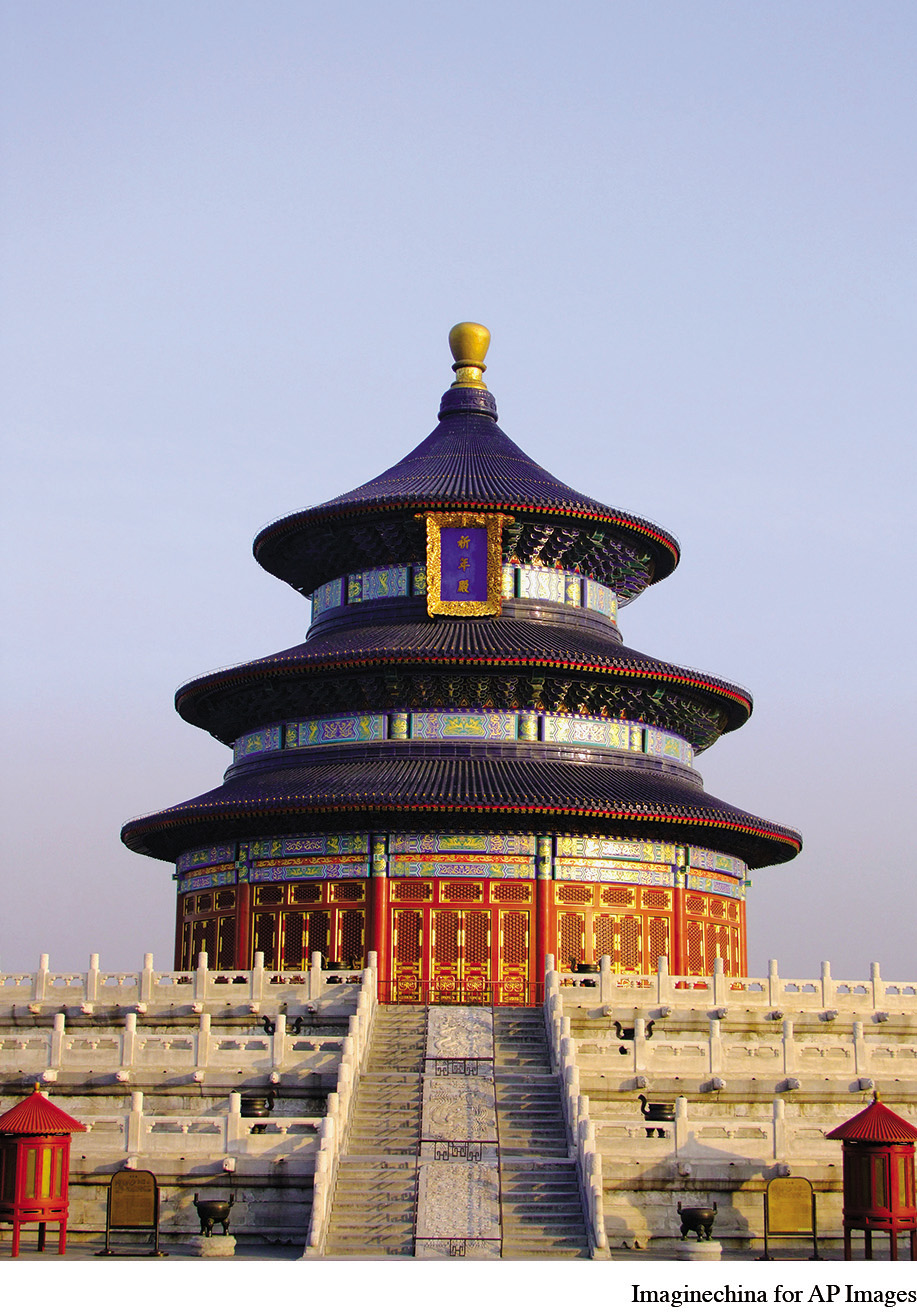Ways of the World with Sources
Printed Page 505
Ways of the World
Printed Page 423
Chapter Timeline
Ming Dynasty China
Such a traveler might well begin his or her journey in China, heir to a long tradition of effective governance, Confucian and Daoist philosophy, a major Buddhist presence, sophisticated artistic achievements, and a highly productive economy. That civilization, however, had been greatly disrupted by a century of Mongol rule, and its population had been sharply reduced by the plague. During the Ming dynasty (1368–1644), however, China recovered (see Map 12.1). The early decades of that dynasty witnessed an effort to eliminate all signs of foreign rule, discouraging the use of Mongol names and dress, while promoting Confucian learning and orthodox gender roles, based on earlier models from the Han, Tang, and Song dynasties. Emperor Yongle (YAHNG-leh) (r. 1402–1422) sponsored an enormous Encyclopedia of some 11,000 volumes. With contributions from more than 2,000 scholars, this work sought to summarize or compile all previous writing on history, geography, philosophy, ethics, government, and more. Yongle also relocated the capital to Beijing, ordered the building of a magnificent imperial residence known as the Forbidden City, and constructed the Temple of Heaven, where subsequent rulers performed Confucian-based rituals to ensure the well-being of Chinese society. Two empresses wrote instructions for female behavior, emphasizing traditional expectations after the disruptions of the previous century. Culturally speaking, China was looking to its past.
How would you define the major achievements of Ming dynasty China?

Temple of Heaven Set in a forest of more than 650 acres, the Temple of Heaven was constructed in the early fifteenth century. In Chinese thinking, it was the primary place where Heaven and Earth met. From his residence in the Forbidden City, the Chinese emperor led a procession of thousands twice a year to this sacred site, where he offered sacrifices, implored the gods for a good harvest, and performed the rituals that maintained the cosmic balance. (Imaginechina for AP Images)
Politically, the Ming dynasty reestablished the civil service examination system that had been neglected under Mongol rule and went on to create a highly centralized government. Power was concentrated in the hands of the emperor himself, while a cadre of eunuchs (castrated men) personally loyal to the emperor exercised great authority, much to the dismay of the official bureaucrats. The state acted vigorously to repair the damage of the Mongol years by restoring millions of acres to cultivation; rebuilding canals, reservoirs, and irrigation works; and planting, according to some estimates, a billion trees in an effort to reforest China. As a result, the economy rebounded, both international and domestic trade flourished, and the population grew. During the fifteenth century, China had recovered and was perhaps the best governed and most prosperous of the world’s major civilizations.
China also undertook the largest and most impressive maritime expeditions the world had ever seen. Since the eleventh century, Chinese sailors and traders had been a major presence in the South China Sea and in Southeast Asian port cities, with much of this activity in private hands. But now, after decades of preparation, an enormous fleet, commissioned by Emperor Yongle himself, was launched in 1405, followed over the next twenty-eight years by six more such expeditions. On board more than 300 ships of the first voyage was a crew of some 27,000, including 180 physicians, hundreds of government officials, 5 astrologers, 7 high-ranking or grand eunuchs, carpenters, tailors, accountants, merchants, translators, cooks, and thousands of soldiers and sailors. Visiting many ports in Southeast Asia, Indonesia, India, Arabia, and East Africa, these fleets, captained by the Muslim eunuch Zheng He (JUHNG-huh), sought to enroll distant peoples and states in the Chinese tribute system (see Map 12.1). Dozens of rulers accompanied the fleets back to China, where they presented tribute, performed the required rituals of submission, and received in return abundant gifts, titles, and trading opportunities. Chinese officials were amused by some of the exotic products to be found abroad—ostriches, zebras, and giraffes, for example. Officially described as “bringing order to the world,” Zheng He’s expeditions served to establish Chinese power and prestige in the Indian Ocean and to exert Chinese control over foreign trade in the region. The Chinese, however, did not seek to conquer new territories, establish Chinese settlements, or spread their culture, though they did intervene in a number of local disputes. (See Zooming In: Zheng He.)
The most surprising feature of these voyages was how abruptly and deliberately they were ended. After 1433, Chinese authorities simply stopped such expeditions and allowed this enormous and expensive fleet to deteriorate in port. “In less than a hundred years,” wrote a recent historian of these voyages, “the greatest navy the world had ever known had ordered itself into extinction.”5 Part of the reason involved the death of the emperor Yongle, who had been the chief patron of the enterprise. Many high-ranking officials had long seen the expeditions as a waste of resources because China, they believed, was the self-sufficient “middle kingdom,” requiring little from the outside world. In their eyes, the real danger to China came from the north, where barbarians constantly threatened. Finally, they viewed the voyages as the project of the court eunuchs, whom these officials despised. Even as these voices of Chinese officialdom prevailed, private Chinese merchants and craftsmen continued to settle and trade in Japan, the Philippines, Taiwan, and Southeast Asia, but they did so without the support of their government. The Chinese state quite deliberately turned its back on what was surely within its reach—a large-scale maritime empire in the Indian Ocean basin.
